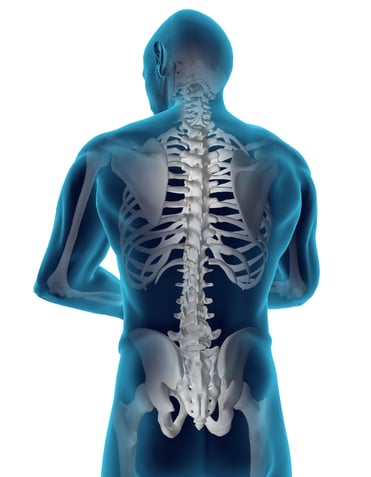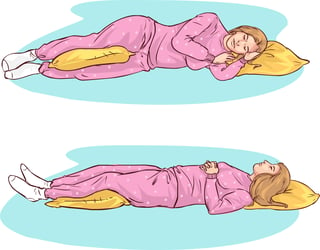
Although there are a number of causes for the breathing problems that are associated with chronic obstructive pulmonary disease (COPD), experts have of late started studying the link between posture and COPD.
A community member at COPD.net asked a very interesting question in relation to this: “I am having issues with bad posture - for example leaning forward and hunching my shoulders without even realizing it. Could this be related with COPD and what can help me?”
One expert, Leon C. Lebowitz, Technical Director of the Respiratory Therapy department at the Brookdale Hospital and Medical Center in Brooklyn and founding member of the New York Downstate Association for Respiratory Therapists (NYDART, Inc.), responded to this question, saying even though posture is not going to cure or prevent your COPD, it can help reduce your shortness of breath through opening up your chest more so that breathing is easier for the lungs and muscles involved in breathing.
When you sit or stand slouched over, your sternum and ribcage press against your diaphragm. This bad posture will cause your body to have to work harder in order to breathe properly. Remember, when you have COPD your body is already working extra hard to facilitate normal breathing and allow you to get enough oxygen in to your lungs. Poor posture increases the difficulty.
Sitting Posture
The posture you have while sitting down plays a huge role in your breathing ability. While COPD is a disease mainly characterized by shortness of breath, other factors like excitement, physical activity, adverse weather conditions and strong scents can trigger these symptoms, compromising your ability to breathe even more. You can use the steps outlined below together with breathing strategies such as diaphragmatic breathing and pursed lip breathing to help improve your posture as well as make breathing a bit easier for you.
COPD is a disease mainly characterized by shortness of breath, other factors like excitement, physical activity, adverse weather conditions and strong scents can trigger these symptoms, compromising your ability to breathe even more. You can use the steps outlined below together with breathing strategies such as diaphragmatic breathing and pursed lip breathing to help improve your posture as well as make breathing a bit easier for you.
Posture 1
- Rest your feet flat on the floor at all times.
- Lean your chest slightly forward, rather than straight up.
- Rest your elbows on your knees and if needed rest your chin in your hands.
- Relax the muscles within your neck and shoulder area.
Posture 2
- Rest your feet flat on the floor at all times.
- Lean your chest slightly forward, rather than straight up.
- Use a table to rest your arms directly in front of your body.
- Rest your head on your forearms or use a pillow.
Standing Posture
Many do not realize the importance of maintaining a good posture while standing and the role it plays in your ability to breathe properly. These suggestions below can help you maintain the correct posture while standing up.
role it plays in your ability to breathe properly. These suggestions below can help you maintain the correct posture while standing up.
Posture 1
- Keep your feet separated at a shoulder’s width apart.
- Use a wall to rest your hips on.
- Use your thighs to rest your hands.
- Keep your shoulders relaxed, leaning slightly forward and dangle your arms in front of you.
Posture 2
- Use a piece of furniture to rest your hands or elbows, keeping them below the height of your shoulders.
- Use your forearms to rest your head, allowing your neck to relax.
Keep your shoulders relaxed.
Sleeping Posture

The posture you use while sleeping will not only improve the quality of your sleep but also help you breathe better during the hours that you are asleep. A number of people do not realize the impact a good posture has on improving their sleep until they change it and start noting the benefits. Below are some suggestions to help you improve your posture while sleeping.
Posture 1
- While lying on your side, place one pillow as a guard between your legs (at the knees), and another pillow under your head to keep your head elevated.
- Keep your back straight once the pillows are in place.
Posture 2
- Lie on your back with a pillow under your head to keep your head elevated and bend your knees.
- Place a pillow under your knees.
While these few changes may not look like a big deal or seem minor compared to other therapies, they can make a huge difference in easing your work to breathe. Changing your posture may seem hard at first and may not come naturally however, after just a short time of reinforcement, it will become second nature to you.
 Lyn Harper is the director of respiratory care at White Plains Hospital in White Plains, NY. She leads the COPD team that trains the patients to manage COPD through lifestyle adjustments, regular visits to their pulmonogist, sticking to their medication, and recognition of flare-ups.
Lyn Harper is the director of respiratory care at White Plains Hospital in White Plains, NY. She leads the COPD team that trains the patients to manage COPD through lifestyle adjustments, regular visits to their pulmonogist, sticking to their medication, and recognition of flare-ups.
She responded to the question that was posed saying that hunching your shoulders and leaning forward may be related to COPD and often may be how one relieves the feeling of their inability to breathe.
The next time you find yourself doing this, try to take note whether it was caused by shortness of breath and you automatically leaned forward to ease this. You may also start pursed lip breathing from this position, which is another way to ease breathlessness.
You should carefully monitor this because if it is more of a continuous posture problem, it could actually have the opposite effect and interfere with your ability to take deep breaths. The steps below can help you test your posture in front of a full length mirror;
- Place a chair facing sideways in front of a full length mirror and sit down.
- Close your eyes and stand up straight as quickly as you can.
- Open your eyes and examine the posture that you are standing in.
Are your shoulders slouched forward?
Is your chest caved in?
Does your head appear to be tilted backwards?
If you answer is yes to any of these questions, you may need to improve your posture by performing a few exercises. The first obstacle to correcting your posture is acknowledging that you need to work on it.
Exercises that you can do to improve your posture include;
- Doing chin tucks and neck extensions while sitting in a chair to help strengthen your neck. Hold each exercise for a few seconds and then release.
- Do shoulder stretches – it could be just a matter of standing up and pulling your shoulders backwards as far as you can and hold the position for a few seconds. This will help with the slumping shoulders.
- Should it progress to the point where it affects your ability to breathe, you should speak to your health-care provider about it. A few sessions with a physical therapist can at times also really work magic for you.



